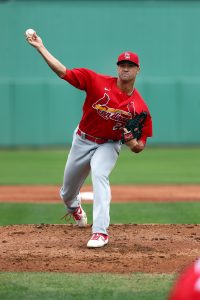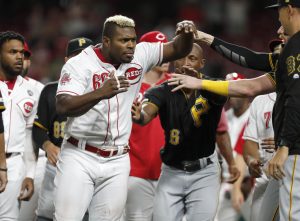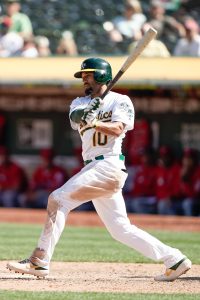For a big-budget team that has in recent years added high-profile players like Bryce Harper, Andrew McCutchen, and Jake Arrieta, the Phillies sure haven’t received a lot of attention of late. Perhaps it’s the fact that the rest of the NL East has been engaged in more interesting pursuits.
Let’s not overlook the challenges facing the Philadelphia organization in 2020 and beyond. The Nationals just won a World Series and still have elite talent. The Braves have taken the past two division titles and remain loaded. The Mets took a hit with the loss of Noah Syndergaard, but still have an imposing rotation and and an underappreciated amount of upside on the position-player side as well. And the Marlins? Well, we tend to overlook them, but maybe it’s time we recognize that the club’s young pitching is fairly interesting. They even spent some cash to bring in some veterans this offseason. Perhaps a renaissance isn’t far off.
Could the Phillies’ long-awaited return to the top of the heap stall out? There’s a real risk of it. Projection systems mostly seem to view the current roster as a generally average one, hardly a surefire contender. And the farm system isn’t exactly bursting with top-shelf youngsters just awaiting their chance in the majors. It’s necessary to acknowledge that the picture may never quite come all the way together as president Andy MacPhail and GM Matt Klentak envisioned. But let’s also consider the realistic upside in the group of players they’ve assembled.
Outfield
Bryce Harper: It has been a few years, but he’s only 27 and is one of only a few players who has proven capable of producing a ~10 WAR season.
Andrew McCutchen: Cutch was nearly that good at his peak, too, though it’s much further in the past. But we shouldn’t go too far in the other direction. McCutchen has been a high-quality everyday player even since moving out of superstar status. Added rest for his knee probably helps.
Adam Haseley/Roman Quinn/Jay Bruce: I’m not going to tell you I’m in love with this group, but you can squint and see how it can work out. Statcast hated Haseley’s quality of contact and Quinn hasn’t made good with his chances. But they’re both young players who could yet make strides. Bruce wasn’t great in Philly last year but has mostly been an above-average offensive producer even in his decline years.
Infield
J.T. Realmuto: The Phillies feel he’s the best catcher in baseball and it’s possible there’s even more in the tank. He has done more offensively than he did in 2019. There’ll be no shortage of motivation with free agency beckoning.
Rhys Hoskins: He collapsed late last year but still led the league in walks. If he can figure out what went wrong … he was a .263/.401/.530 monster through his first 392 plate appearances in 2019.
Didi Gregorius: We’re looking at a guy who was a quality defensive shortstop who produced about 25% more offensive than the average player in 2018. He wasn’t back to that level after fighting back from Tommy John surgery, but as with Hoskins, the established ceiling isn’t that far in the rearview mirror.
Jean Segura: A steady producer for three seasons before the Phillies acquired him, Segura stumbled a bit last year. But when you look under the hood, he mostly seems to be the same player, so it wouldn’t be surprising at all if he was to bounce back at thirty years of age.
Alec Bohm: The team’s top prospect bolted up the ladder last year and ended up posting big numbers at Double-A (.269/.344/.500; 38:28 K/BB ratio). He’s a candidate to break out upon his MLB arrival.
Utility
Scott Kingery: It’s important to remember that the Phillies can lean on Kingery in the infield or the outfield. That leaves flexibility to accommodate the rise of Bohm, needs in center field, or opportunities to add new players. Kingery had some ups and downs in his second season in the bigs, but ultimately made huge strides and turned in a league-average offensive season.
Josh Harrison/Neil Walker/Logan Forsythe/T.J. Rivera: The Phillies promised opportunities to compete in camp to a series of veterans who’ve had quite a bit of MLB success. That’s not necessarily likely to result in a lucky score of a high-quality regular, but it’s possible. And the team can reasonably hope it has added some useful pieces for cheap.
Rotation
Aaron Nola: He took a bit of a step back last year but was still quite good. And Nola put up a Cy Young-caliber effort in the season prior.
Zack Wheeler: This signing was all about the upside positively dripping from Wheeler’s high-powered right arm. There are risks, too, but there’s also a real possibility the Phils hit a home run here.
Jake Arrieta: As with McCutchen, it’d be foolish to pine for a return to the glory days. But Arrieta had turned in quality output even with diminished stuff before running into bigger problems in 2019. He was a sub-4.00 hurler in the two prior campaigns.
Vince Velasquez/Nick Pivetta/Zach Eflin: It’s something of an annual tradition to marvel at the big arms of Velasquez and Pivetta while wondering if they can succeed as MLB starters. It hasn’t really happened yet, but there have been flashes and crazier things have happened. Eflin’s peripherals slipped last year and he doesn’t exactly profile as an ace, but he has turned in 291 1/3 innings of 4.23 ERA ball in the past two seasons.
Cole Irvin/Enyel De Los Santos/Adonis Medina/Spencer Howard: Irvin and De Los Santos have reached (but hardly mastered) the majors. It’s possible to imagine solid production coming from either or both. There are some highly regarded arms not far behind. It seems both of these hurlers have some development left, but when talent figures things out it can move quickly …
Bullpen
Hector Neris: He got the long balls under control in 2019 and returned to being one of the game’s more effective closers.
Tommy Hunter/David Robertson: It’s hard to count on too much, but these accomplished veterans could certainly have a rebound. The layoff will give extra time for both to rest and rehab.
Bud Norris/Anthony Swarzak/Blake Parker/Drew Storen: There are also a fair number of other veteran types looking to revive their careers in Philadelphia. Tough to say what to expect, but there are decent odds that there’s some productivity here. Norris is a particularly interesting candidate; he was quite useful in 2018 but sat out the ensuing season when interest didn’t develop as expected.
Victor Arano: He was quite good in 2018 and now has added time to recover from elbow surgery.
Deolis Guerra: The MLB track record is quite thin, but he thrived in a tough Triple-A environment last year.
Adam Morgan/Jose Alvarez/Ranger Suarez/Francisco Liriano: It’s not a star-studded group of lefties, but there is at least sufficient depth.
The Phils also have a fairly large group of younger pitchers already on the 40-man, many with MLB experience. While few jump off the page for their obvious upside, the Phillies can still hope that someone emerges from the group. Edgar Garcia may be the most interesting, with big swinging-strike rates and good results in the upper minors. There are three lefties with strong upper-minors strikeout numbers but other questions: Austin Davis, Garrett Cleavinger, and Kyle Dohy.
Remember, the bullpen is likely to end up with some spillover from the rotation, with Pivetta a particularly likely candidate to spend time in the ’pen. Hope remains that his stuff could play up in a relief role.
Overall
It’s silly to contemplate a scenario where literally everything breaks right for a team. That’s more or less impossible. But the realistic upside possibilities are fairly interesting. There’s potential for one mega-star (Harper), at least one top-of-class player (Realmuto), and several others with All-Star capabilities in the position-player mix. The pitching picture is similar, with a set of mid-prime hurlers who could emerge as twin aces and a reasonably interesting blend behind them.
Many have pegged the Phils as the fourth-best team in the NL East, and that’s quite possible accurate when you blend in all the downside. But this club still has the potential to break out — particularly if a strong early showing facilitates additional mid-season investments (presuming there’s such an opportunity).



